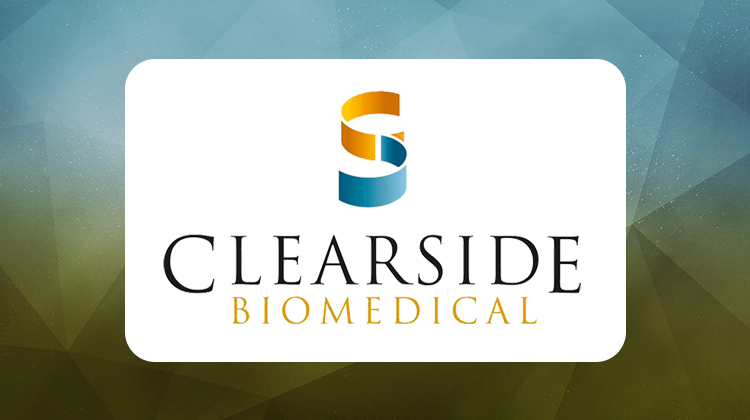Clearside Goes All in for CLS-TA

Late last year, when developers of agents that combined anti-platelet derived growth factor with an anti-vascular endothelial growth factor (anti-PDGF/anti-VEGF) to treat wet age-related macular degeneration (AMD) disclosed disappointing trial results, Daniel White, president and CEO of Clearside Biomedical, took notice.
At the time, Clearside had just raised $20 million. The Alpharetta, GA, biotech was anticipating top-line data from Phase II trials of its lead candidate CLS-TA delivered through the suprachoroidal space directly to the retina and choroid for macular edema in noninfectious uveitis and in combination with intravitreal Eylea (aflibercept, Regeneron) for treatment of macular edema associated with retinal vein occlusion (RVO). All the while, Clearside had been pursuing a preclinical program for its anti-PDGF/anti-VEGF multikinase inhibitor axitinib for the treatment of wet AMD. CLS-TA is a proprietary, preservative-free formulation of triamcinolone acetonide.
Clearside’s Hard Turn
But those aforementioned disappointing trials of anti-PDGF/anti-VEGF combinations factored into Clearside’s latest move to take a hard turn away from the axitinib program to focus more on CLS-TA in combination with Eylea for treatment of diabetic macular edema (DME).
Last fall, Regeneron disclosed the Phase II trial of its rinucumab-Eylea combination for treatment of wet AMD failed to meet its primary endpoint (Eye on Innovation, October 5, 2016). A few weeks later, Ophthotech Corporation disclosed that Phase III results of its anti-PDGF Fovista combined with Lucentis (ranibizumab, Genentech) did not show superiority to Lucentis alone for wet AMD (Eye on Innovation, December 15, 2016). The results sent Ophthotech’s stock reeling, currently trading 90% below its pre-announcement levels.
Multikinase inhibitors like anti-PDGF agents “have been a bit suspicious overall in retinal treatment,” White told Eye on Innovation, “but we thought with our distribution and location in the suprachoroidal space where we administer the drug that it would be a better approach than administering the drug intravitreally.”
However, he added, Regeneron’s and Ophthotech’s failures with anti-PDGF agents “made us kind of scratch our heads a little bit about whether or not in the clinic we would see some of the things that we were seeing in animals.”
Showing Promise in RVO
Meanwhile, the clinical data White and his team started seeing with CLS-TA in RVO drew their attention. At OIS@AAO 2016, White previewed Phase II results that showed 60% fewer injections in the CLS-TA-Eylea arm than in the Eylea-only arm, and those patients on CLS-TA-Eylea showed a visual acuity gain of 18.9 letters versus 11.3 letters in the Eylea-only arm. The Tanzanite study also demonstrated significantly fewer patients, 18 of 23, required additional injections during the three-month study period and little incidence of steroid-like side effects commonly seen with intravitreal steroid delivery.
The efficacy of anti-VEGF therapy in RVO has been well documented. “But what we didn’t realize is that by combining steroid and anti-VEGF in the early phases of development, particularly in naive patients, that we would see an additional visual acuity benefit above just anti-VEGF alone,” White told Eye on Innovation. Clearside is trying to replicate those Phase II results in the Phase III SAPPHIRE study.
Turning Toward DME
And Clearside investigators are trying to apply what they’ve learned in RVO to DME. “We see DME as a closer opportunity than wet AMD,” White said. “That usually drives resources and high probability of success. That’s really maximizing our current lead compound. DME is an extremely large market with an unmet medical need. We still see anti-VEGF having an important contribution there, but by no means are anti-VEGF agents doing everything that’s required for that particular disease. We’ve seen data where nearly 50% of these patients are not getting to their optimal retinal thickness and vision outcome with just anti-VEGF alone.”
Enrollment in the Phase I/II HULK trial in DME is nearly complete, White said. Many of the sites in the RVO program will participate.
More than 200 physicians are now trained in using the suprachoroidal delivery platform that’s the centerpiece of Clearside’s strategy, and the company has engaged the American Medical Association to obtain a CPT code for the procedure.
In addition, Clearside continues to explore other uses of its suprachoroidal delivery platform beyond triamcinolone, White said. “We’re looking at a number of different programs: gene therapy, complement inhibition, and other retinal vascular disease as well as wet AMD. We believe that this approach provides ideal access to the choroid and retina directly, and we’re finding that many companies are wanting to consider this as an alternative to existing administration approaches.”
Richard Mark Kirkner is contributing editor of Eye on Innovation and has covered health care for three decades.
